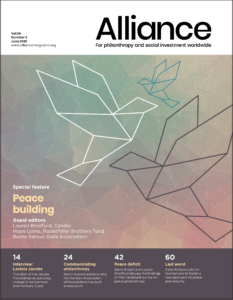Alliance magazine’s June 2019 issue affirmed what many of us in the peace, peacebuilding, and humanitarian communities feared: peace-related philanthropy makes up less than one per cent of total global philanthropic giving. The Alliance editorial team argues that this seems ‘irresponsibly small given that armed conflict spoils lives, divides societies and ruins economies.’ We, the advocates, agree, particularly given that the United Nations’ latest displacement reporting found that the number of people fleeing conflict is the highest since World War II – with 70.8 million people displaced worldwide, at least.
The issue detailed a number of philanthropic challenges and trepidations in taking on peace as a core portfolio issue — challenges with measurement, focus, evidence, and scale. For philanthropists struggling with these challenges but eager to scale up peace-supportive investments, the Global Fragility Act now moving through the United States Congress is an important vehicle to track.
The Global Fragility Act of 2019 (GFA) is as a once in a generation legislative opportunity to establish a new US policy framework for reducing violence and preventing armed conflicts in fragile states and regions. The bipartisan bill, co-sponsored by Chairman Eliot Engel and Ranking Member Michael McCaul in the House and Chairman Lindsay Graham and Senator Chris Coons in the Senate, would establish the first-ever whole-of-government effort to address the risks of fragility by stabilising conflict-affected areas and preventing violence and conflict globally. As written, the bill is slated to authorise $1.1 billion over five years to kickstart a Global Fragility Initiative by focusing in on 6 focus countries or regions of priority concern.
Importantly for philanthropists, the GFA specifically calls for private sector, philanthropic and academic partnership in this effort. Specifically, the legislation directs the United States President, Secretary of State, Administrator of USAID, and Secretary of Defense to:
- ‘identify mechanisms to improve coordination between the United States, foreign governments, and international organisations, including the World Bank, the United Nations, regional organisations, and private sector organisations;
- Describe ‘potential areas of improved public and private sector research and development, including with academic, philanthropic, and civil society organisations, on data collection efforts and more effective approaches to stabilise conflict-affected areas and prevent violence and fragility globally;’ and
- ‘address efforts to expand public-private partnerships and leverage private sector resources;’
Each of these clauses are direct invitations to the philanthropic community to lean (back) into peacebuilding. Members of Congress know that governments alone cannot tackle the generation-defining challenge of rising levels of violence, polarisation, and war. They seek partnerships with philanthropists and others to tackle violence and fragility at the same scale that governments and philanthropic leaders have worked to tackle HIV/AIDs, eradicate preventable disease, and advance global food security.
The Global Fragility Act also invites philanthropists that may not consider themselves as ‘peace and security’ philanthropist to join in and assess how their efforts can contribute to peace and conflict prevention. By directing the administration to ‘address the long-term underlying causes of fragility and violence,’ the GFA invites experts in climate change mitigation, economic inequities, education, governance and other development challenges to assess how to advance peace and stability objectives. While we know that business-as-usual development will not automatically reduce or prevent violence, we also know that by 2030, as many as 80 per cent of people living in extreme poverty will be in 31 countries where fragile states, corruption, poor economic conditions, and violent conflict prevail. This means that to end extreme poverty, all development actors will have to reconcile with fragile, conflict and abusive governance. The GFA takes into consideration all of these trendlines and invites new peace-focused innovations across development sectors.
For these reasons and more, the Global Fragility Act has the potential to build new bridges between government, philanthropic, private, and civil society efforts to build peace and prevent conflict in fragile states. We hope to see more and more philanthropists step up to the plate.
Madeline Rose is the director of coalition campaigns and policy for the Alliance for Peacebuilding and director of its +Peace Coalition
 Peace-related philanthropy, at less than 1 per cent of all grantmaking, seems irresponsibly small given that armed conflict spoils lives, divides societies and ruins economies.
Peace-related philanthropy, at less than 1 per cent of all grantmaking, seems irresponsibly small given that armed conflict spoils lives, divides societies and ruins economies.
Our new issue goes in search of philanthropy’s role in peaceful development.






Comments (0)